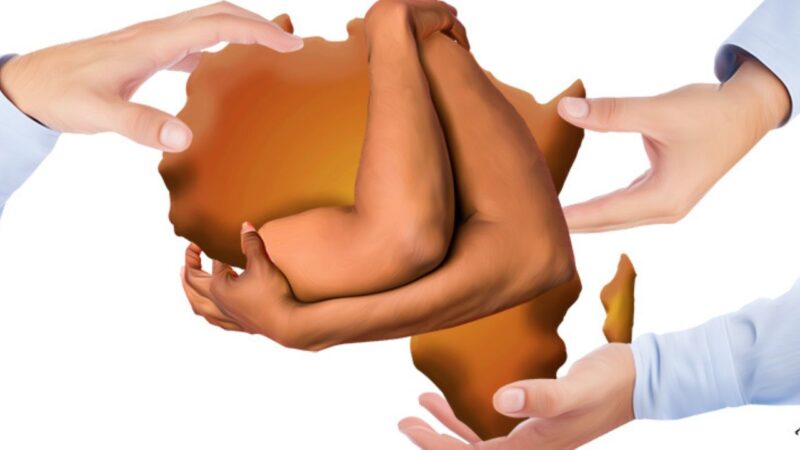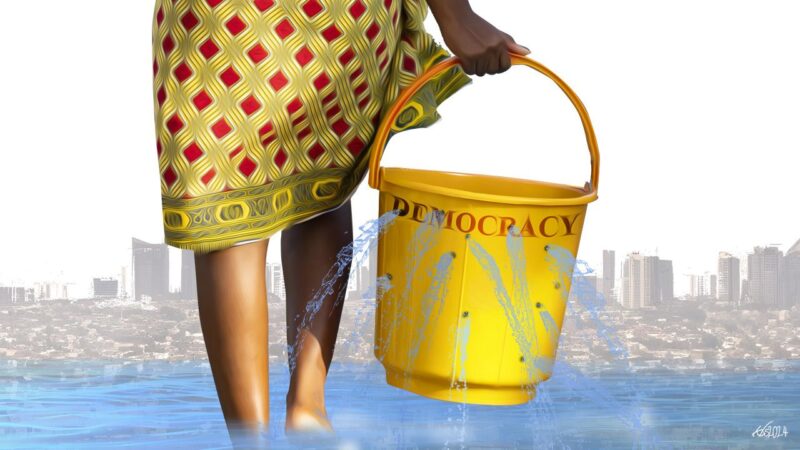Kenya’s constitution classifies all land in Kenya as either public, community-owned or private. More than 65 per cent of Kenya’s landmass is estimated to be community land. Such land is occupied and used mainly by the pastoralist communities in the northern drylands of Kenya. This area produces roughly 89 per cent of the beef produced in the country; mutton and chevron are not included in the government statistics. Beef is by far the most popular meat consumed in Kenya. It represents more than 70 per cent of all the meat consumed by volume due to urbanisation and a growing demand from the middle class in Kenyan cities.
Pastoralism, as practiced on the unregistered community lands by the indigenous people in Kenya, is of significant economic worth. The annual national pastoralist livestock offtake was valued at US$0.189 billion, while the yearly meat offtake was estimated at 154,968 tonnes and valued at US$0.389 billion. There is consensus that pastoralism contributes about 13 per cent of Kenya’s Gross Domestic Product (GDP), with approximately 13 million people directly benefiting from the livestock value chain. Over 75 per cent of cattle herds in Kenya are kept by pastoralists, who supply the bulk of the meat consumed.
But the economic contributions of pastoralists are hardly reflected in the government’s strategies or national development plans. As a result, pastoralism continues to face setbacks that hinder the realisation of its full potential. Further, the absence of accurate or, in some cases, the use of outdated data and inappropriate valuation methods, leads to an underestimation of the contribution of pastoralists to the economy.
The constitution protects a person’s right to own property individually or in association with others without any form of discrimination. Further, the state cannot deprive any person of their property or interest in a property unless it is in accordance with the constitution and the established statutory law. In the case where land, whether registered or not, is compulsorily acquired by the state for a public purpose or in the public interest, the constitution requires that it be done on the principles of just compensation and prompt payment of its total value.
Pastoralists rarely obtain just compensation for land acquired compulsorily by the state because the system of community land valuation is unjust towards the people.
Community land governance
The Land Act 2012 is the primary framework that governs public and private land administration and management while community land governance is addressed under the Community Land Act 2016. The Community Land Act repealed the Land (Group Representatives) Act (Cap 287) and the Trust Lands Act (Cap 288), which previously provided for the administration and management of community lands in Kenya.
The Community Land Act defines a community as a consciously distinct and organised group of users of the community land who are citizens of Kenya and share common attributes. These attributes are common ancestry, similar culture or unique mode of livelihood, socio-economic or other similar common interests, geographical space, ecological space, or ethnicity.
Pastoralists rarely obtain just compensation for land acquired compulsorily by the state because the system of community land valuation is unjust towards the people.
The Community Land Act 2016 provides for the recognition, protection, and registration of community land rights. Community land in Kenya is owned and vests the power to appropriate in the community. The Act further stipulates that the communities shall hold the communal land as family or clan land, reserve land, or any other category of land recognised under the Act or other written law. In addition, community land can be held in land tenure systems such as customary, freehold, leasehold or any other tenure system recognised by law. Community land includes all land owned by the former group ranches, community forests, grazing areas, shrines, land traditionally held by hunter-gatherer communities, land lawfully held as trust land by the county governments, and any other land legally declared to be community land by law.
Any parcel of community land that is not registered under the Community Land Act remains unregistered community land to be held in trust by the county governments on behalf of the communities. The county is prohibited by the Community Land Act from selling, transferring or disposing of any parcel of unregistered community land or even converting it into private Land.
Compulsory land acquisition
The statutory provisions under the Land Act 2012 guide the determination of compensation for compulsorily acquired community land rights. In addition, subsidiary legislation in the form of rules to guide assessment for just compensation has been developed by the National Land Commission (NLC) and approved by the national parliament.
The Kenyan government introduced an unfair adjustment to the Land Value Index Laws Amendment Bill 2019 that was hurriedly passed by both houses (the National Assembly and the Senate) and assented to by the president. The Land Value Amendment Bill aimed to amend various sections of the Land Act 2012, the Land Registration Act 2012, the Prevention, Protection and Assistance of Internally Displaced Persons and Affected Communities Act, and provide for the assessment of Land Value Index with regard to compulsory land acquisition. Pastoralist communities raised concerns through the Kenya ASAL Advocacy Group (KAAG) regarding the amendment’s serious implications for the just and fair compensation for pastoralist rangelands.
The amendment effectively entrenched unfair government policies and practices that include zero-rating the value of pastureland and legitimised unjust compensation practices of acquiring community land by keeping secret the full appreciation of the rangeland value.
Moreover, parliament passed the Land Value Index amendment law without the usual scrutiny by the members of the Pastoralist Parliamentary Group (PPG). The PPG is the largest parliamentary caucus representing the pastoralist communities of 15 counties in Kenya. The members of the national parliament founded the PPG to provide political leadership and protect and safeguard the interests of the pastoralist people at the national level.
By the passing such laws and policies, the government routinely undervalues and undermines pastoralism as a system of production and main source of livelihood in the drylands. Government statistics undervalue land used by the pastoralists, contributing to higher poverty indices and environmental degradation in the pastoralist region. Government-generated indices and valuation models do not capture the total value of rangelands and their uses, violating the constitutional protection of the pastoralist communities’ right to its common property.
Valuation practice in Kenya
The valuation practice in Kenya is governed by the Valuers Act Cap 532, which provides a Valuers Registration Board that regulates registered valuers’ activities and conduct. Any person registered by the board must be a full member of the Institution of Surveyors of Kenya (ISK).
Being members of the ISK, valuers in Kenya are required to subscribe to the International Valuation Standards (IVS) set by the International Valuation Standards Council. These standards specify the concepts, approaches, and bases for undertaking valuation in Kenya. The standards, guidelines, principles, and ideas are expected to promote consistency and transparency in valuation practice in Kenya. The standards prescribe three approaches that underpin these valuation methods: the market approach, the income approach and the cost approach.
The government’s statistics undervalue land used by the pastoralists, contributing to higher poverty indices and environmental degradation in the pastoralist region.
The market approach derives the value of an asset by comparing the asset with comparable (similar) assets for which sale price information is available. It assumes all assets are sold and bought in an open market. The income approach establishes value by converting future cash flow from an asset to a single present value, taking account of time value for money. It assumes assets are held for investment purposes.
The cost approach seeks to determine the value of an asset using the economic principle that a buyer will pay no more for an asset than the cost to obtain an asset of equal utility, whether by purchase or by construction in normal circumstances. Based on the foundations of these approaches, the following valuation methods have been variably applied in the valuation of assets in Kenya: Direct Sales Comparison (Comparable); Income Capitalization (Investment); Profits (Accounts); Replacement Cost; Reproduction Cost; summation (Contractors).
Valuation in community rangelands in Kenya
What is to be valued?
Valuation of community lands can be located from the constitution’s definition, which, as stated earlier, holds that community land include land registered in the name of group representatives (group ranches); land lawfully transferred to a specific community or declared to be community land by an Act of Parliament; land lawfully held, managed or used by specific communities as community forests, grazing areas or shrines; ancestral lands and lands traditionally occupied by hunter-gatherer communities; and land lawfully held as trust land by the county governments. On the face of it, the issue seems straightforward enough, but the practical disaggregation of attributes and interests in context is complex and displays excellent heterogeneity.
Turkana community system
The topography of Turkana County is varied, comprising of lowlands, plains, and mountains. The soils are sandy, volcanic, clay, alluvial and mixed types. There is fertile farming land (both irrigated and non-irrigated) on the lower Turkwel river basin, grazing pasture lands, forests, wildlife areas, caves and historical sites, mining and petroleum production areas, fishing sites, and beekeeping sites. Land use outside the urban areas varies depending on the ecological and geological characteristics, cultural and traditional practices, and government and non-governmental influences.
Significant land use practices include livestock keeping, fishing, subsistence farming, beekeeping, hunting and gathering, mining, cultural ceremonies and social gatherings, worship, tourism, and forestry. These uses may change depending on the seasons and climatic conditions.
Farming land is, for instance, converted to grazing land during the dry season and after crops have been harvested. The physical extent of community land is not defined by conventional administrative or cadastral boundaries but on cultural, use and control bases. Cultural definitions of boundaries vary depending on the rights under consideration. For instance, the more significant territorial boundary includes the areas occupied by the nineteen (19) Turkana subgroups (the outer boundary). Each of the subgroups also has its boundaries within the area that is covered by the external boundary. Families also have their boundaries defined by trees under the Ekwar system. Individuals also have control areas known as Eree.
The Turkana cultural property rights over this land are a continuum that includes territorial control, and ownership is collective. All subgroup use and control, family use and control, Individual use and control, individual ownership and control in irrigation schemes, access for members across and within subgroup-controlled areas, access and use by neighbours and friends of families for some resources such as water from wells (Akare) and use by neighbouring communities outside the territorial boundary, migratory rights, all these rights are exercised within customary rules and regulations that are not in writing but are well known and respected by all community members.
Community land ownership and management in Marsabit County
The land within Marsabit County comprises diverse landscapes, including high altitude mountains with rain forests, other forests, farmlands, grasslands, deserts, lakeshores and desert oases. The landscapes are characterised by volcanic, loamy, sandy and clay soils, and rock outcrops. Significant land uses vary across these landscapes and include livestock keeping, fishing, subsistence farming, hunting and gathering, social and cultural activities including traditional religious practices, extraction of traditional medicines and herbs, forestry, tourism and wildlife.
Some areas have mixed uses, like agro-pastoralism, while others have a specific use such as pastoralism. The land outside the municipal territory is traditionally owned by four specific ethnic communities: Borana, Rendille, Gabra and El Molo. Each of these communities has different territorial zones that they have historically controlled and used. The boundaries of the territorial zones are identified by geographical features that are historically acknowledged and known and respected by all. The land is not under a formal cadastral and land administration system.
Each of the communities has a different cultural background and clear customary rules governing land use and occupation.
Despite the various communities having distinct land control and ownership rights, they have developed reciprocal use rights for pastureland and water resources. The elders of the respective communities administer the customary practices. The clans, families and individuals in these communities have collective ownership rights, occupation rights, and user rights for pasture and other natural resources in the rangelands.
Families also have their boundaries defined by trees under the Ekwar system.
The community exercises control over any settlements even though it practices pastoralism that is characterised by temporary settlements. As a rule, communities may not graze in one area for more than three months continuously to avoid degradation. Permanent settlements are mainly found in the urban areas and market centres.
Neighbouring communities have mobile access and use rights subject to the customary rules and regulations of the host communities that are often overseen by individual elders appointed by the community’s traditional council. The various landscapes have different uses at different times. For instance, the desert is used for grazing during the rainy season, whereas the highlands are used for grazing during the dry season. All communities share the oases through appointed community regulators. At times cultural events affect land use. For instance, the circumcision period among the Rendille community may dictate where the animals, especially the camels, will be allowed to graze. The land is viewed as a symbol of community identity and the physical features of historical and cultural events.
The Dheda system of the Borana of Isiolo County
The Merti rangeland comprises the areas outside Isiolo central, which are largely dry season grazing areas. There are also wet season grazing areas, small subsistence farming areas, several small pastoralist towns with markets, and one growing urban settlement. The Borana people classify areas using the term Dheda.
The landscape is primarily savannah grassland with some hills and plateaus and varying vegetation cover. The soils are mainly sandy and mixed soils. The dominant land use is livestock keeping, complemented by small-scale subsistence farming along the Ewaso Nyiro riverbank, social amenities, and cultural and traditional shrines. In addition to these uses, the land is the central defining feature for community identity and the foundation of the traditional livestock production system (pastoralism).
The boundaries for the rangelands are determined by geographical features that are historically recognised by the communities, such as hills, seasonal rivers, rangeland water points and other types of rangeland resources related to pasture within each Dheda.
The clans, families and individuals in these communities have collective ownership rights, occupation rights, and user rights for pasture and other natural resources in the rangelands.
The rangeland is mainly occupied and controlled by the Borana community. The clans, families and individuals do not have direct control over the rangelands. Elders govern it on the basis of customary rules and regulations. Families and individual members have user and access rights. Community members cannot dispose of land by sale or exchange since the land is considered an intergenerational community asset. Neighbouring communities from Marsabit, Wajir, Garissa and Samburu have migratory use and access rights that are defined by the Borana community’s rules and regulations. These rights are seasonal, and the neighbouring communities cannot establish permanent settlements in the grazing areas.
There are community boreholes situated in different locations to provide water for both livestock and people. They are controlled by elders to avoid use during unauthorised seasons or as a disincentive to permanent settlement. This ensures that the grazing patterns are maintained to prevent land degradation or depletion of pasture before the onset of the rainy seasons.
From the case studies of these three communities, it is clear that the subject of valuation should vary across these different communities taking into account their specific customs and practices, the physical attributes of the land, and the region’s economic activities. The valuation should have legal, economic, social, cultural and environmental dimensions that will vary depending on the purpose, the community’s context, and timing. Community land valuation variables are not only influenced by the host community but also by the interests of neighbouring communities, including access, user rights and their social-economic activities. Some of these variables, such as those related to culture and spiritual practices, may not be directly quantifiable in the national valuation framework.
Neighbouring communities from Marsabit, Wajir, Garissa and Samburu have migratory use and access rights that are defined to the Borana community’s rules and regulations.
Besides state interests and frameworks, the rights and tenure arrangements that comprise the subject of valuation also contain several bundles that include individual, family, clan, ethnic subgroup, ethnic group and neighbouring ethnic groups. In the process of valuation, the physical scope should be ascertained by social mapping that considers cultural and social dynamics. However, the government’s current cadastral system does not allow for this.
In light of the foregoing, it is necessary to review how community land valuation for the purposes of compulsory land acquisition is done in Kenya. Whether relying on real estate background, livelihood safeguards or ecological management, the statutes that guide valuation in the case of compulsory community land acquisition by the state must adopt new guidelines that comply with constitutional requirements and legal and policy changes.








